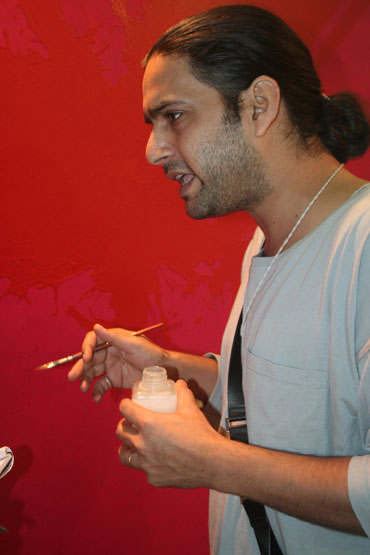
You meet all sorts of interesting people at Lakme Fashion Week. Like artist Prashast Kachru, for whom stains are a form of artistic expression.
Among the busy crowd of buyers and designers at the Lakme Fashion week stands a man in a ponytail with a paintbrush in hand, carefully detailing a piece of art, undeterred by the hustlebustle around. I advance to him and enquire about his activity.
"I am an artist by profession and I am applying varnish to this painting," he explains. And what is he painting? "It's a paan (betel leaf) stain," he replies with a smile.
Intriguing as all this sounds, I want to probe further.
Could he be a firang? Cause his diction says so and he pauses between words while talking. He introduces himself as Prashast Kachru, a 35-year-old from Delhi who was invited to paint by an emerging retail brand, online private shopping club Fashion AndYou.
Paan stains? Really?
Yes, I love painting stains. They are interesting. Don't you feel so?
But what i it about painting stains that intrigues you?
A few years ago, I was on a scholarship exchange programme at Ecole Nationale Superieure des Beaux-arts in Paris, when a renowned artist who had visited the college spoke about the emerging presence of abstract art. He went on to remark that abstract painting was a Western phenomenon.
After a year, I came back to Delhi, but I realised that the thought of finding something abstract that was truly Indian stuck deep in my head. That's when my eyes fell upon the numerous betel nut stains everywhere I went. In buses, trains, apartments -- they are a part of our everyday life.
I observed that each stain was different from the other. It had an individual character and created different patterns on different canvases. That's how it occurred to me that paan stains were an Indian source of inspiration for painting stains. I have been working on it for the last few years and I have discovered different dimensions to paint stains.
What were your learnings from painting stains?
I did a lot of research and readings about the perception of the aam junta. When the Britishers and other countrymen visited India for the first time, the first impression they had about our country was that we are a primitive people.
No matter how rich or talented we were, the minute they saw a common man on the road and spoke to him/her, the stained teeth would be visible and that would turn them off immediately.
So stains were looked down upon and so were stained people.
I wanted to change that impression and wanted people to perceive stains also as a characteristic unique to our country and most importantly, as a piece of art as well.
Do you intend to change people's perception through your paintings? Is there a message you want to convey?
Not really. I have travelled to a lot of places. In one of the places where I stayed, next to Bhutan, I met people who had an entirely different perception of betel nut stains. According to them, the redder the stains were among men, the more strong and masculine they were considered. Similarly, among women, the redder the lips were, the more sex appeal they generated. Interesting as it sounds, abstract art is also about perception. While some people find it wacky and crazy, there is a section of art lovers who appreciate the art form.
So, besides paan, what other stains have you worked on in the past?
Last time, I worked on boot polish. The show was hosted in Mumbai. You won't believe that the Boot Polish series was an instant hit and people loved my paintings. Art is all about perception and the way an artist is able to attract attention to his creative output.